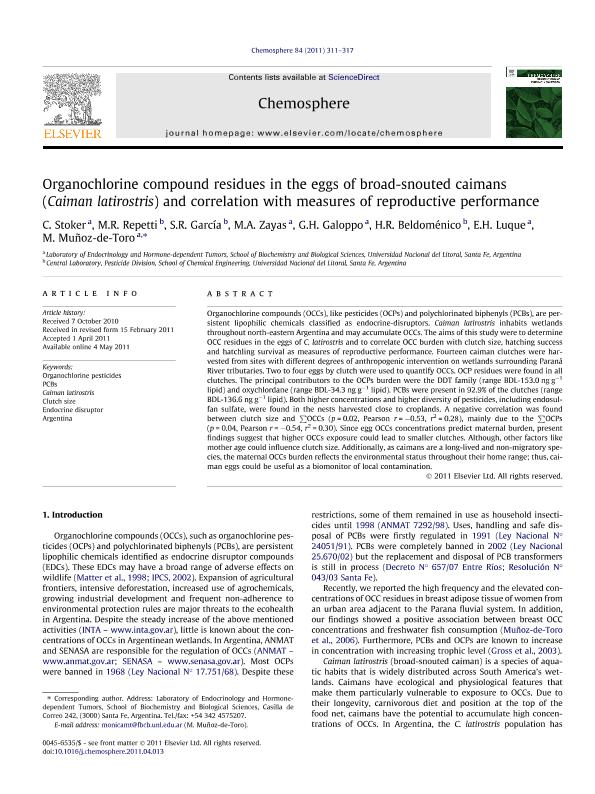Mostrar el registro sencillo del ítem
dc.contributor.author
Stoker, Cora

dc.contributor.author
Repetti, María Rosa

dc.contributor.author
García, S.R.
dc.contributor.author
Zayas, Marcelo Alejandro

dc.contributor.author
Galoppo, Germán Hugo

dc.contributor.author
Beldoménico, H.R
dc.contributor.author
Luque, Enrique Hugo

dc.contributor.author
Muñoz de Toro, Monica Milagros

dc.date.available
2020-03-23T14:20:09Z
dc.date.issued
2011-06
dc.identifier.citation
Stoker, Cora; Repetti, María Rosa; García, S.R.; Zayas, Marcelo Alejandro; Galoppo, Germán Hugo; et al.; Organochlorine compound residues in the eggs of broad-snouted caimans (Caiman latirostris) and correlation with measures of reproductive performance; Pergamon-Elsevier Science Ltd; Chemosphere; 84; 3; 6-2011; 311-317
dc.identifier.issn
0045-6535
dc.identifier.uri
http://hdl.handle.net/11336/100632
dc.description.abstract
Organochlorine compounds (OCCs), like pesticides (OCPs) and polychlorinated biphenyls (PCBs), are persistent lipophilic chemicals classified as endocrine-disruptors. Caiman latirostris inhabits wetlands throughout north-eastern Argentina and may accumulate OCCs. The aims of this study were to determine OCC residues in the eggs of C. latirostris and to correlate OCC burden with clutch size, hatching success and hatchling survival as measures of reproductive performance. Fourteen caiman clutches were harvested from sites with different degrees of anthropogenic intervention on wetlands surrounding Paraná River tributaries. Two to four eggs by clutch were used to quantify OCCs. OCP residues were found in all clutches. The principal contributors to the OCPs burden were the DDT family (range BDL-153.0ngg-1 lipid) and oxychlordane (range BDL-34.3ngg-1 lipid). PCBs were present in 92.9% of the clutches (range BDL-136.6ngg-1 lipid). Both higher concentrations and higher diversity of pesticides, including endosulfan sulfate, were found in the nests harvested close to croplands. A negative correlation was found between clutch size and ∑OCCs (p=0.02, Pearson r=-0.53, r2=0.28), mainly due to the ∑OCPs (p=0.04, Pearson r=-0.54, r2=0.30). Since egg OCCs concentrations predict maternal burden, present findings suggest that higher OCCs exposure could lead to smaller clutches. Although, other factors like mother age could influence clutch size. Additionally, as caimans are a long-lived and non-migratory species, the maternal OCCs burden reflects the environmental status throughout their home range; thus, caiman eggs could be useful as a biomonitor of local contamination.
dc.format
application/pdf
dc.language.iso
eng
dc.publisher
Pergamon-Elsevier Science Ltd

dc.rights
info:eu-repo/semantics/openAccess
dc.rights.uri
https://creativecommons.org/licenses/by-nc-sa/2.5/ar/
dc.subject
ARGENTINA
dc.subject
CAIMAN LATIROSTRIS
dc.subject
CLUTCH SIZE
dc.subject
ENDOCRINE DISRUPTOR
dc.subject
ORGANOCHLORINE PESTICIDES
dc.subject
PCBS
dc.subject.classification
Otras Ciencias Biológicas

dc.subject.classification
Ciencias Biológicas

dc.subject.classification
CIENCIAS NATURALES Y EXACTAS

dc.title
Organochlorine compound residues in the eggs of broad-snouted caimans (Caiman latirostris) and correlation with measures of reproductive performance
dc.type
info:eu-repo/semantics/article
dc.type
info:ar-repo/semantics/artículo
dc.type
info:eu-repo/semantics/publishedVersion
dc.date.updated
2020-03-16T15:00:40Z
dc.journal.volume
84
dc.journal.number
3
dc.journal.pagination
311-317
dc.journal.pais
Países Bajos

dc.journal.ciudad
Amsterdam
dc.description.fil
Fil: Stoker, Cora. Universidad Nacional del Litoral. Facultad de Bioquímica y Ciencias Biológicas; Argentina
dc.description.fil
Fil: Repetti, María Rosa. Consejo Nacional de Investigaciones Científicas y Técnicas. Centro Científico Tecnológico Conicet - Santa Fe. Instituto de Salud y Ambiente del Litoral. Universidad Nacional del Litoral. Instituto de Salud y Ambiente del Litoral; Argentina
dc.description.fil
Fil: García, S.R.. Universidad Nacional del Litoral. Facultad de Ingeniería Química; Argentina
dc.description.fil
Fil: Zayas, Marcelo Alejandro. Universidad Nacional del Litoral. Facultad de Ingeniería Química; Argentina
dc.description.fil
Fil: Galoppo, Germán Hugo. Universidad Nacional del Litoral. Facultad de Bioquímica y Ciencias Biológicas; Argentina
dc.description.fil
Fil: Beldoménico, H.R. Consejo Nacional de Investigaciones Científicas y Técnicas. Centro Científico Tecnológico Conicet - Santa Fe. Instituto de Salud y Ambiente del Litoral. Universidad Nacional del Litoral. Instituto de Salud y Ambiente del Litoral; Argentina
dc.description.fil
Fil: Luque, Enrique Hugo. Consejo Nacional de Investigaciones Científicas y Técnicas. Centro Científico Tecnológico Conicet - Santa Fe. Instituto de Salud y Ambiente del Litoral. Universidad Nacional del Litoral. Instituto de Salud y Ambiente del Litoral; Argentina
dc.description.fil
Fil: Muñoz de Toro, Monica Milagros. Universidad Nacional del Litoral. Facultad de Bioquímica y Ciencias Biológicas; Argentina
dc.journal.title
Chemosphere

dc.relation.alternativeid
info:eu-repo/semantics/altIdentifier/url/http://www.sciencedirect.com/science/article/pii/S0045653511004048
dc.relation.alternativeid
info:eu-repo/semantics/altIdentifier/doi/http://dx.doi.org/10.1016/j.chemosphere.2011.04.013
Archivos asociados
